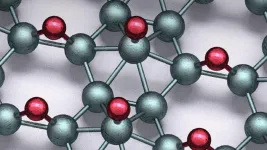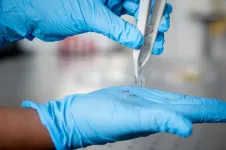Surgical technique may reduce positive margin rate in breast cancer patients with DCIS
2021-04-05
(Press-News.org) WINSTON-SALEM, N.C. - April 5, 2021 - According to the American Cancer Society, a noninvasive breast cancer called ductal carcinoma in situ (DCIS) accounts for approximately one of every four new breast cancer cases in the United States. If left untreated, DCIS has the potential to evolve into invasive cancer, so many patients choose to have breast-conserving surgery or mastectomy after a diagnosis.
However, obtaining clear or negative margins -- no cancer cells in the outer edge of removed tissue -- is critical to mastectomy success as positive margins are associated with higher rates of recurrence.
A new study from Wake Forest School of Medicine suggests removing additional tissue around the tumor cavity, a technique known as cavity shave margin resection, reduces the rate of positive margins in patients with DCIS. The findings are published online in the April 2021 issue of the Journal of the American College of Surgeons.
"Our previous clinical trial showed that this technique can reduce positive-margin rates in invasive disease by at least 50%, but to my knowledge, this is the first analysis involving pure DCIS," said Marissa Howard-McNatt, M.D., director of the Breast Cancer Center at Wake Forest Baptist Health and associate professor of surgical oncology at Wake Forest School of Medicine, part of Wake Forest Baptist.
Researchers randomized 109 patients with pure DCIS (no invasive cancer) from 10 centers across the U.S., and 58 (53.2%) of these patients were randomized for cavity shave margin resection. In this group, researchers noted a nearly 65% reduction in the positive-margin rate.
According to Howard-McNatt, achieving clear margins in patients with DCIS can be difficult due to the continuous and branching nature of the spread of this disease. Clear margins free of cancer are vital in decreasing the chance of recurrence of cancer in the breast.
"Our study shows a significant reduction in positive margins," Howard-McNatt said. "This technique should be considered for DCIS patients."
INFORMATION:
ELSE PRESS RELEASES FROM THIS DATE:
2021-04-05
A new study published in Indoor Air provides design-based solutions on how to best use ultraviolet germicidal irradiation (UVGI) to disinfect occupied rooms without harming individuals. This research was conducted by Dorit Aviv, assistant professor of architecture and director of the Thermal Architecture Lab at the University of Pennsylvania Stuart Weitzman School of Design, Penn visiting scholar Miaomiao Hou, and Jovan Pantelic, an air quality expert at Katholieke Universiteit Leuven.
Ultraviolet germicidal irradiation (UVGI) devices use short-wavelength ultraviolet ...
2021-04-05
Palmer Amaranth is a high-impact agronomic weed species that has cost the United States agriculture industry billions of dollars since its discovery outside of its native range in the southwestern U.S. and northwestern Mexico. Over the last 20 years, it has moved further north, and now poses a major threat to corn, soybean, and cotton growers across the south and Midwest regions of the United States.
It is not legal to sell any kind of seed in Minnesota if the seed lot contains Palmer Amaranth. The problem is this particular invasive species--which has shown potential to wipe out up to 91% of corn yields, 68% of soybean yields, and 54% of cotton yields-- is difficult to visibly distinguish from ...
2021-04-05
Scientists create stable nanosheets containing boron and hydrogen atoms with potential applications in nanoelectronics and quantum information technology.
What's thinner than thin? One answer is two-dimensional materials -- exotic materials of science with length and width but only one or two atoms in thickness. They offer the possibility of unprecedented boosts in device performance for electronic devices, solar cells, batteries and medical equipment.
In collaboration with Northwestern University and the University of Florida, scientists from the U.S. Department of Energy's (DOE) Argonne National Laboratory report in Science ...
2021-04-05
How do we become a complex, integrated multicellular organism from a single cell?
While developmental biologists have long researched this fundamental question, Stanford University biologist and HHMI investigator Dominique Bergmann's recent work on the plant Arabidopsis thaliana has uncovered surprising answers.
In a new study, published April 5 in Developmental Cell, led by Bergmann and postdoctoral scholar Camila Lopez-Anido, researchers used single-cell RNA sequencing technologies to track genetic activity in nearly 20,000 cells as they formed the surface and inner parts of an Arabidopsis leaf. Through this highly detailed technique, the researchers captured ...
2021-04-05
PHILADELPHIA - A team led by scientists at the Perelman School of Medicine at the University of Pennsylvania has illuminated the functions of mysterious structures in cells called "nuclear speckles," showing that they can work in partnership with a key protein to enhance the activities of specific sets of genes.
The discovery, which will be published on April 5 in Molecular Cell, is an advance in basic cell biology; the key protein it identifies as a working partner of speckles is best known as major tumor-suppressor protein, p53. This avenue of research may also lead to a better future understanding of cancers, and possibly better cancer treatments.
"This study shows that nuclear speckles work as major regulators of gene expression, and suggests that ...
2021-04-05
UNIVERSITY PARK, Pa. -- Approximately 40,000 children in the United States may have lost a parent to COVID-19 since February 2020, according to a statistical model created by a team of researchers. The researchers anticipate that without immediate interventions, the trauma from losing a parent could cast a shadow of mental health and economic problems well into the future for this vulnerable population.
In the researchers' model, for approximately every 13th COVID-related death, a child loses one parent. Children who lose a parent are at higher risk of a range ...
2021-04-05
CHICAGO - A new study shows that youth arrested as juveniles with psychiatric disorders that remain untreated, struggle with mental health and successful outcomes well beyond adolescence.
Research from Northwestern Medicine shows nearly two-thirds of males and more than one-third of females with one or more existing psychiatric disorders when they entered detention, still had a disorder 15 years later.
The findings are significant because mental health struggles add to the existing racial, ethnic and economic disparities as well as academic challenges from missed school, making a successful transition to adulthood harder to attain.
"Kids get into trouble during adolescence.Those from wealthier families also use drugs and get into fights. But these situations are most often ...
2021-04-05
What The Study Did: Researchers estimated and projected the number of children in the United States affected by the death of a parent from COVID-19.
Authors: Rachel Kidman, Ph.D., of Stony Brook University in Stony Brook, New York, is the corresponding author.
To access the embargoed study: Visit our For The Media website at this link https://media.jamanetwork.com/
(doi:10.1001/jamapediatrics.2021.0161)
Editor's Note: The article includes conflict of interest disclosures. Please see the article for additional information, including other authors, author contributions and affiliations, conflict of interest and financial disclosures, and funding and support.
INFORMATION:
Media advisory: The full study is linked to this news release.
Embed this link to provide your readers ...
2021-04-05
CLAREMONT, CA - Keck Graduate Institute (KGI) Assistant Professor and University of California, Berkeley Visiting Scientist Dr. Kiana Aran first introduced the CRISPR-Chip technology in 2019. Now just two years later, she has expanded on its application to develop CRISPR-SNP-Chip, which enables detection of single point mutations without amplification in Sickle Cell Disease and Amyotrophic lateral sclerosis (ALS).
"The field of CRISPR-based diagnostics is rapidly evolving due to CRISPR programmability and ease of use," Aran says. "However, the majority of CRISPR-based diagnostics platforms are still relying on target amplifications or optical detections. The reprogrammability of CRISPR combined with optics-free highly scalable graphene transistors will allow us to bring the ...
2021-04-05
A new study, out this week, could pave the way to revolutionary, transparent electronics.
Such see-through devices could potentially be integrated in glass, in flexible displays and in smart contact lenses, bringing to life futuristic devices that seem like the product of science fiction.
For several decades, researchers have sought a new class of electronics based on semiconducting oxides, whose optical transparency could enable these fully-transparent electronics.
Oxide-based devices could also find use in power electronics and communication technology, reducing the carbon footprint of our utility networks.
A RMIT-led team has now introduced ultrathin beta-tellurite to the two-dimensional (2D) semiconducting material family, providing ...
LAST 30 PRESS RELEASES:
[Press-News.org] Surgical technique may reduce positive margin rate in breast cancer patients with DCIS


